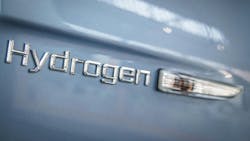Hydrogen-powered trucking: Where the U.S. stands
Key takeaways:
- The U.S. produces roughly 10 million metric tons of hydrogen annually, although most of it is used by the petroleum and coal products industry (68%) and the chemicals manufacturing industry (21%).
- Using the element as a trucking fuel requires even more (and cleaner) production.
- Government incentives are essential for the growth of hydrogen production.
There has been a push to use hydrogen as a fuel source for decades, but the road to get there has been bumpy.
As of 2022, there are 33 hydrogen production facilities in the U.S., which produce roughly 10 million metric tons of hydrogen annually, according to the U.S. Energy Information Administration, using the most recent data available.
Most of this hydrogen was purchased by the petroleum and coal products industry (68%) and the chemicals manufacturing industry (21%), primarily to produce ammonia and derivatives, the EIA states.
With this much production and with industries already using hydrogen in large quantities, why is it that the transportation industry—specifically trucking—can't seem to get on board?
See also: Can hydrogen actually work for trucking operations?
The state of hydrogen use today
Hydrogen is used in different applications. These include: power-to-power, which uses excess electricity to create electricity that can be stored for use at a later time; power-to-gas, which combines hydrogen with natural gas to create synthetic methane; power-to-industry (the most popular use of hydrogen in the U.S. today), where hydrogen is used in chemical production processes; power-to-fuel, where hydrogen is combined with existing fuels to power existing engines; and power-to-mobility, Omar Chaudhary, sales and business development manager at Accelera, said in a recent industry webinar.
Of the hydrogen produced across the globe, less than 1% is used as a fuel; however, transportation sectors that are difficult to electrify, such as aviation and shipping, have shown interest in developing the hydrogen fuel market.
“There has been a significant push from airlines recently,” Chaudhary said. “Both United Airlines as well as Delta have signed [a memorandum of understanding] to essentially convert a big portion of their fleet to use [sustainable aviation fuel]. So, we're noticing an uptick in these applications currently.”
There have also been significant developments in trucking to enable hydrogen as a fuel. OEMs have developed hydrogen fuel cell EVs and hydrogen combustion-powered vehicles.
Accelera, a business unit of U.S.-based engine manufacturer Cummins, provides electrolyzers for use at hydrogen refueling stations to advance the adoption of hydrogen as a fuel in the trucking industry. While the demand for electrolyzers has increased across the globe—Chaudhary referenced areas such as Canada and Germany—there is little growth in the U.S. due to the lack of policy support, Chaudhary said.
Hydrogen production in the U.S.
There are approximately nine different methods of hydrogen production in the U.S., according to Rick Mihelic, director of emerging technologies at the North American Council for Freight Efficiency. Each of these methods is noted by a different color: green hydrogen, blue hydrogen, and so on.
Further, each method results in hydrogen that isn’t created equal. These different colors signify the carbon intensity of the hydrogen produced. Carbon intensity is the measure of carbon dioxide or other greenhouse gases per unit of “activity,” Chevron states.
One method of hydrogen production is known as electrolysis, which uses electricity to split water into hydrogen and oxygen, Chaudhary said.
Green hydrogen is produced when electrolysis uses renewable energy; pink hydrogen is produced by nuclear-powered electrolysis; and yellow hydrogen is produced with electrolysis using direct solar energy and nanotechnology.
See also: Hydrogen fuel cell tech is growing even more long-haul capable
However, most hydrogen production facilities that exist in the U.S. are considered “gray hydrogen” facilities, meaning they produce more greenhouse gas emissions. Yet, some companies are working to build blue hydrogen production facilities, Connor Dolan, VP of external affairs for the Fuel Cell and Energy Association, said.
Blue hydrogen’s production method is similar to gray hydrogen production. It uses natural gas or methane to produce hydrogen, yet instead of allowing the greenhouse gases to emit into the atmosphere, blue hydrogen production reduces the emissions that leak into the atmosphere through a “carbon capture and storage” process.
This CCS process essentially captures the CO2 and permanently stores it deep underground, according to National Grid.
One facility is in development in Louisiana, the Air Products’ Louisiana Clean Energy Complex.
“It's a $4.5 billion investment,” Dolan said. Once it’s operational, the hydrogen produced will be used “for a variety of use cases, including blue ammonia that will be exported to global markets or sharing that blue hydrogen down the distribution pipelines that they already have around the Gulf to a number of their customers.”
Another facility in development is Exxon Mobil’s Baytown facility, with an investment upwards of $10 billion. It will be the largest hydrogen production facility in the world upon completion, Dolan said.
“It's going to produce a billion cubic feet per day of low-carbon hydrogen,” Dolan explained. “It's going to be used for both the existing refinery operations down in Baytown, Texas, and that surrounding area outside Houston, as well as generating blue ammonia for export opportunities.”
But even current gray hydrogen production facilities could be retrofitted as blue hydrogen facilities, and converting to blue hydrogen would also create thousands of jobs for Americans, Dolan said.
See also: Bosch: ‘We’re still heavily involved in hydrogen’ as trucking’s future fuel
How friendly is the Trump administration to hydrogen production?
Unfortunately, growing hydrogen production in the U.S. is not possible without help from the federal government. The Inflation Reduction Act, passed in 2022, offered tax credits to hydrogen producers whose facilities began construction before January 1, 2033—the cleaner the hydrogen produced, the higher the incentive.
While Dolan said the previous Biden administration didn't do the hydrogen industry “any favors,” (the credit was established in 2022, but the final rulemaking didn’t take place until January 3, 2025), the Trump administration has been “tricky.”
With the current administration, the status of those incentives is uncertain. The incentives, known as 45V, are subject to potential elimination under the current congress—preventing any tax credits to be given to production facilities that begin construction after December 31, 2025. Dolan and other advocates are hoping to prevent this.
“Our focus right now is on the U.S. Senate,” he said. “We're taking a number of steps to try and defend this tax credit and get some restoration back on the table here.”
Without 45V, Dolan believes the companies that want to invest in U.S. hydrogen will simply go elsewhere. “45V was the key differentiator between building clean facilities in the United States versus elsewhere for a lot of these large, major corporations,” he said.
But what's the status of the billions of dollars the Biden administration set aside for regional hydrogen hubs?
Since Trump's inauguration day, many of these hubs haven’t been able to move forward, Dolan explained, and “a lot of them are at risk for getting discontinued moving forward or canceled by the current administration at the Department of Energy.”
“Notably, six out of the seven hubs include heavy-duty transportation solutions as one of their major end-use activities,” Dolan said. “This program was intended to create a national network for hydrogen development, ultimately including long-haul trucking opportunities across the country. We really very much need to keep this program in place, and are actively working on that front."
About the Author
Jade Brasher
Senior Editor Jade Brasher has covered vocational trucking and fleets since 2018. A graduate of The University of Alabama with a degree in journalism, Jade enjoys telling stories about the people behind the wheel and the intricate processes of the ever-evolving trucking industry.

